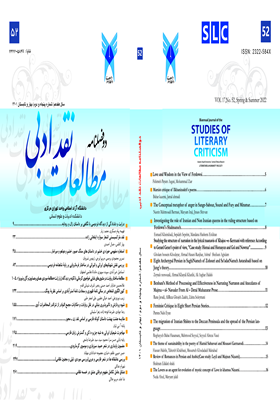Investigating the role of Iranian and Non Iranian queens in the ruling structure based on Ferdowsi's Shahnameh
Subject Areas : مطالعات نقد ادبیesmail Khirabadi 1 , sepide sepehri 2 , Seyedeh Mandana Hashemi Isfahan 3
1 - Ph.D. student of Persian language and literature, Islamic Azad University, Roudhen branch, Roudhen, Iran.
2 - Assistant Professor, Department of Persian Language and Literature, Islamic Azad University, Roudhen Branch, Roudhen, Iran
3 - Assistant Professor, Department of Persian Language and Literature, Islamic Azad University, Roudhen Branch, Roudhen, Iran
Keywords: Iran, Ferdowsi, Government, Keywords: Shahnameh, queens, Farr, Non Iranian,
Abstract :
The most important central element in the entire Shahnameh is the character of the king, which is derived from the two origins of history and mythology. The elements that were effective in the formation of the kings' rule in the Shahnameh are: Divine Farr, Royal Farr (inheritance), wealth and politics, power and having support and social base. Among the fifty-four kings in the Shahnameh, three were women and the rest were men. Shahnameh’s women play a key role in the government because they carry the blood of the kingdom through heredity and play a significant role in the affairs of the country (governance) and army. Sometimes they appear as the king's mother and wife, and sometimes as queens and empresses. This essay has analyzed the rule and foundations of Iranian and Non Iranian queens with analytical-descriptive method and compared the worldliness of male kings with queens. The findings of the research show that three Iranian queens (Homai Chehrazad, Puran Dokht and Azram Dokht) came to power through Royal Farr and the legitimacy of their government was based on fear and terror, except for Homa who was based on vigilance and negative power and two Non Iranian queens (Qidafa and Mother Talchand and Gov) were women with tact and wisdom who sat on the throne with royal and epic Iranian characteristics.
اسلامی، روح الله و وحید بهرامی. (1394). مقالة «پدیدارشناسی سیاسی فرّه در اوستا و شاهنامه»، پژوهشنامة علوم سیاسی، پاییز، سال دهم، شمارة 4، صص 26-28.
اسلامی ندوشن، محمدعلی. (1372). فردوسی، زن، تراژدی. به کوشش ناصر حریری، بابل: کتابسرا.
اصفهانی، حمزه بن حسن (1367)، تاریخ پیامبران و شهریاران، ترجمة جعفر شعار، تهران: امیرکبیر.
ثعالبی، ابومنصور. (1900م). غرر اخبار ملوک الفرس وسیرهم. پاریس: چاپ زوتنبرگ(zotenberg)
خالقی مطلق، جلال. (1393). یادداشتهای شاهنامه. ج5. تهران: مرکز دایره المعارف بزرگ اسلامی.
دورانت، ویل. (1385). تاریخ تمدن. مشرق زمین گاهوارۀ تمدن. ج1. تهران: علمی و فرهنگی.
دهباشی، علی. (1370). فردوسی و شاهنامه. تهران: مدّبر.
دهخدا، علیاکبر (1377)، لغتنامه، تهران: دانشگاه تهران.
رحیمی، مصطفی (1376)، تراژدی قدرت، تهران: نیلوفر.
رستگار فسایی، منصور (1379)، فرهنگ نامهای شاهنامه، دورة ۲ جلدی، تهران: پژوهشگاه علوم انسانی و مطالعات فرهنگی.
سرّامی، قدمعلی (1388)، از رنگ گل تا رنج خار، تهران: علمی و فرهنگی.
ستّاری، جلال(1373)، سیمای زن در فرهنگ ایران، تهران: مرکز.
شاهسواری معصومه؛ حیدری، فاطمه. (1395). «حضور زنان در اسکندرنامه با توجه به نامه ها و روایت ها». فصل نامه تخصصی تحلیل و نقد متون زبان و ادبیات فارسی. شماره 29، صص193-218.
صفا، ذبیح الله. (1390). حماسهسرایی در ایران. چاپ پنجم. تهران: انتشارات فردوس.
عاملی، سید حمید (1381)، بررسی ابعاد فرهنگی و سیاسی جهانی شدن و پیامدهای آن، اصفهان: دانشگاه اصفهان.
فردوسی، ابوالقاسم (1380)، شاهنامه، براساس چاپ مسکو، دورة ۹ جلدی، تهران: ققنوس.
قائمی، فرزاد (1390)، مقالة «داستانهای شاهنامه فردوسی: از استقلال تا انسجام»، مجلة جستارهای ادبی، تابستان، شمارة 173، صص (33-55).
کزازی، جلال الدین. (1380). مازهای راز(جستارهایی در شاهنامه). چاپ دوم. تهران: نشر مرکز.
معین، محمد (1375)، فرهنگ فارسی، تهران: امیرکبیر.
نبئی، مینا؛ فهیمی، رضا. (پاییز 1398). «بررسی مهارت حل مساله در شاهنامه فردوسی». مجله رخسار زبان. شماره 10. صص115-145.
یوسفی فریده. (1382). جایگاه سیاسی اجتماعی زنان در شاهنامه. ساری: شلفین.
_||_

